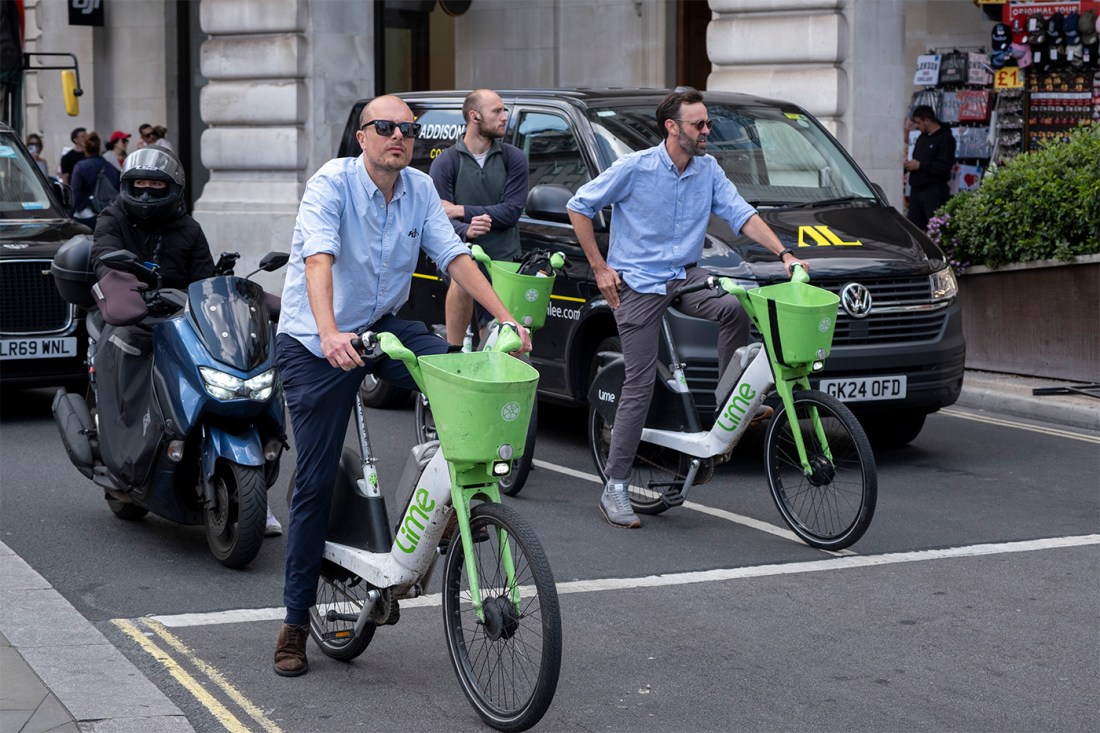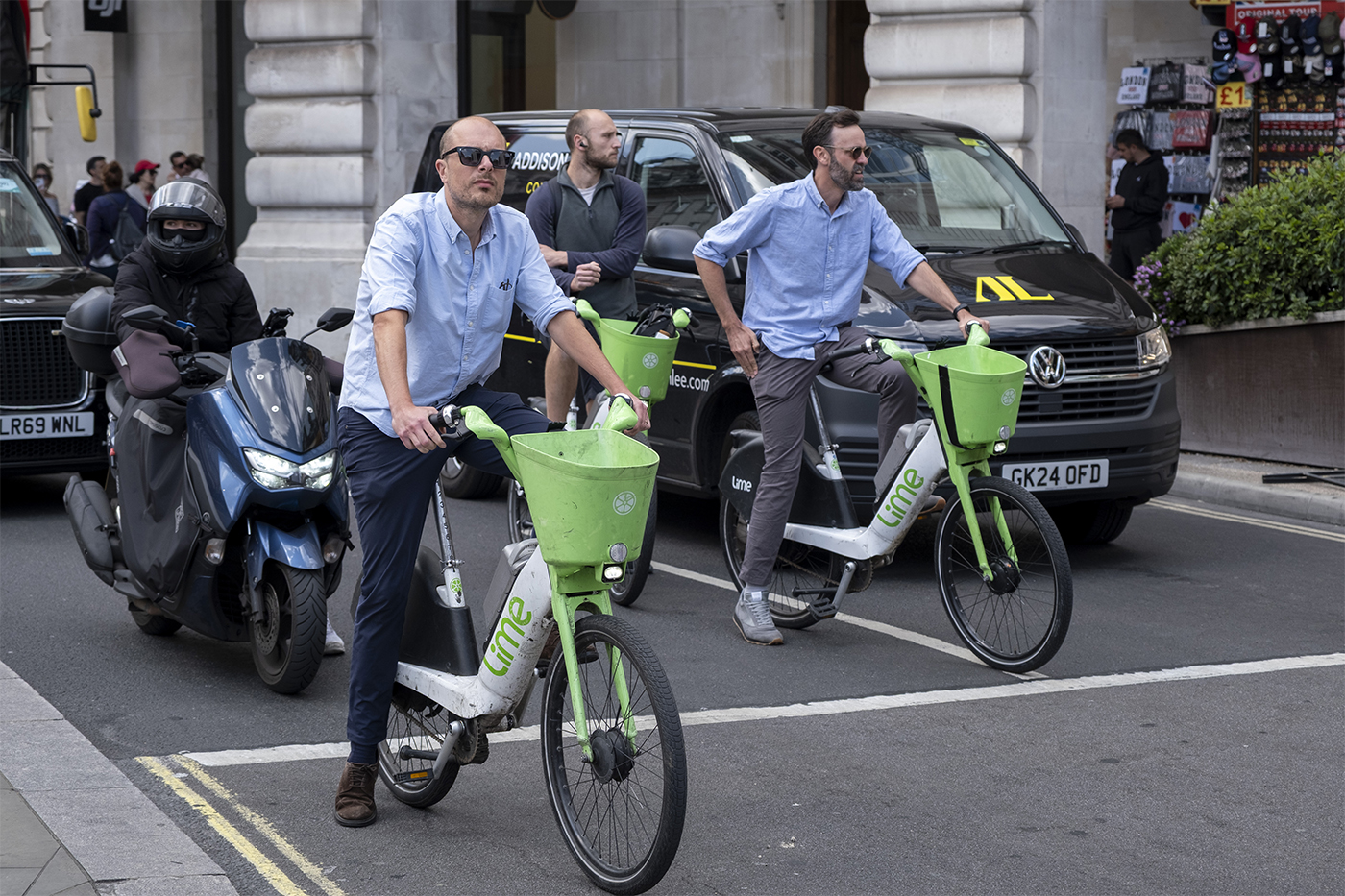Northeastern transport and urban experts examine the popularity of e-bikes and what is hindering them from rivaling bus, metro and rail networks.

LONDON — “I’m going to Lime it” has become a phrase heard frequently on the streets of the world’s major cities.
Lime is not the only international provider of rental electric bikes, but it is the largest, operating in more than 30 countries across five continents, including the United States, the United Kingdom and Australia.
In the City of London — the British capital’s financial district — a survey in 2024 found the use of rental e-bikes had increased rapidly, climbing by 340% in only two years and accounting for one in six bikes on the road in what is known as “the square mile”.
An e-bike boom is being experienced on both sides of the Atlantic. An Ipsos mobility study in 2024 found that one in five households in Europe now owns an electric bike, while the U.S. Department of Energy reported that sales in the States reached 1.1 million in 2022, almost a four-fold increase since 2019.
Ka Ho Tsoi, an assistant professor in transport planning at Northeastern University in London, says e-bikes offer convenience and an immediacy that have helped fuel their popularity.
The lack of physical exertion needed when riding an e-bike, which uses a motor and battery to assist a rider’s pedaling efforts, allows users to travel farther, he says, as well as letting them bypass road congestion and the stress and wait times of transit systems.
“An e-bike also has a very distinctive advantage,” adds Tsoi, “in terms of providing a door-to-door service, whereas bus networks cannot do that in the same way. After getting off the bus, for example, you might still have to walk five to 10 minutes to your destination.
“When a lot of these issues add up, they act as a push factor for people to choose e-bikes over other forms of transportation.”
Urban officials have tended to support the growth of e-bikes as they see them as a way of removing cars from the road and increasing the mobility of people who may struggle with longer journeys on a traditional bike.
A pamphlet titled “Electric bikes in Boston” published by City Hall says that e-bike users on average are older, with around three-quarters of users in the Massachusetts city being over the age of 65.
E-bikes have the ability to connect areas that are underserved by other forms of transportation, according to Jonathan Rokem, a Northeastern associate professor in politics and sustainability.
“They are very good at plugging in parts of a city which haven’t been catered for before, providing easy, accessible transport, something which you can leave anywhere,” says the urban planning specialist.
“It solves a lot of the younger population’s needs in terms of getting from the pub to the Tube or to work. There are lots of these in-between journeys which e-bikes are very good for, and I think that is where they really come into play — it is a really important role that they have in the transport network.”
Hollywood star Timothee Chalamet was recently a walking advertisement for the convenience factor that Tsoi and Rokem mention. The 29-year-old turned up to the London premiere of “A Complete Unknown,” a biopic about singer Bob Dylan in which he plays the lead role, on a Lime bike in order to beat traffic.
But with any booming trend comes negatives. Less considerate e-bikers have been known to carelessly discard their rentals after their trips, leaving them strewn in the middle of sidewalks or even dumping them in canals. The speed at which they can travel means injuries can be far worse for riders and pedestrians during crashes than with standard bicycles. And the “click, clack” noise that Lime and other rental bikes make when their security mechanism is overridden by those not wanting to pay has been described as the “sound of summer,” blighting many cities during the warmer months.
There have been attempts to solve those issues. Lime, a Silicon Valley firm, caps its battery assist at 15 mph. Users are also issued a warning for bad parking. Repeat offenses in the U.K. can lead to fines, starting at £2 ($2.70) and scaling up to £20 ($27) before the account faces a complete ban. Docking services, like Boston’s Bluebike scheme, also make poor parking less of a problem.
One London council upped the ante recently by stating that it will charge companies £80 ($100) for every bike parked dangerously on its streets after local businesses described the parking situation as a “Wild West.” Hackney Council, in east London, plans to create 1,000 designated spaces for dockless e-bike parking that it states will be managed “much more stringently” under a new £93 million ($125 million) contract.
The £80 fines are highly likely to be passed on to users, Tsoi believes, in a move that could deter people from using the service.
“I think they would just shift the responsibility to the user because, after you have used an e-bike, you have to park it in a designated area and then take a photo to complete the journey,” he explains.
“I think [the fines] could cause some hidden problems. If people are worried about the system not working properly and that they could be fined as a result, that could discourage people from using them.”
Rokem says it is clear that better regulation and infrastructure are required if e-bikes are to become a fully integrated form of daily transport.
“We need the supporting infrastructures to support these because otherwise they can become a nuisance to the neighborhood and people start complaining,” he says.
He argues that there needs to be cooperation among local authorities if e-bikes are going to thrive. In London, for example, a rider on a rental e-bike can find that their power cuts out as they cross into another council’s jurisdiction if the company does not have permission to operate. Each borough also has its own rules when it comes to where to park e-bikes.
Dott, a rental e-bike provider, pulled out of London in 2023, opting to instead focus its attention on Paris and Rome, after criticising the patchwork regulation in the city.
Countries like the U.K., says Rokem, need to learn from places like Denmark and Netherlands, which he describes as “bike cultural” countries.
“If you want e-bikes to be part of the future of transport in the U.K., then you need to set your rules of engagement on the policy side. E-bikes are a good in-between option which can cater for a lot of shorter journeys and can connect different transports,” he says.
“It’s not a solution to all the transport problems but it is not supposed to be, in my view. But if we don’t have the supporting infrastructure, the supporting policies, the overarching support so that everyone has the same rules, it will fail.”
Even with the growth in ridership, Tsoi says he does not see e-bikes being able to rival other mass transit networks, mainly due to the hindering factor of distance.
With the majority of urban residents tending to live in the outskirt suburbs of a city for affordability reasons, high-capacity mass transport modes are likely to remain the big players for a long while yet, he argues.
“An e-bike cannot fulfil the purpose of traveling those kinds of distances — you need to have a large metro, rail or bus network to really connect these dots,” says Tsoi.
“If you look at Transport for London data for the share of trips by bike or cycling, it is around 4%. That is because a lot of trips cannot be substituted by bike. I think even in the long term, e-bikes cannot be a direct rival.”
